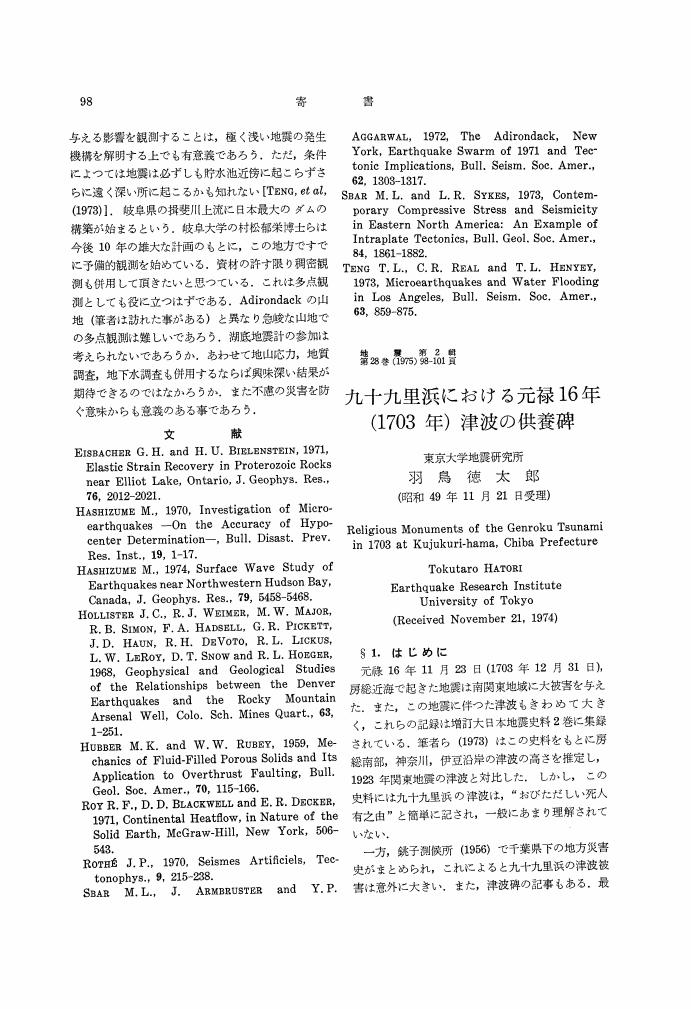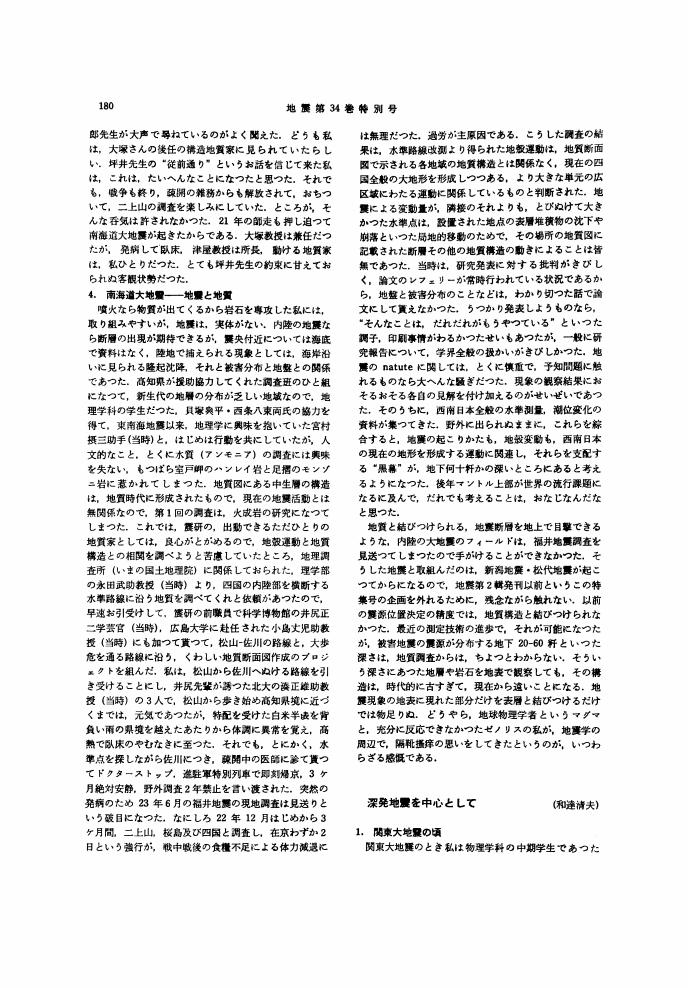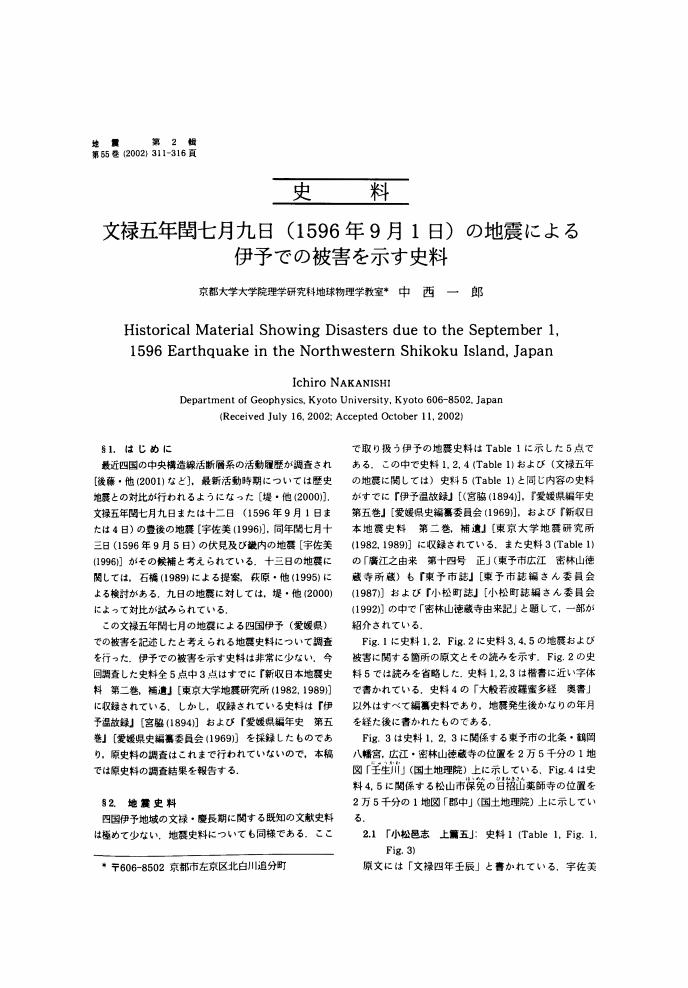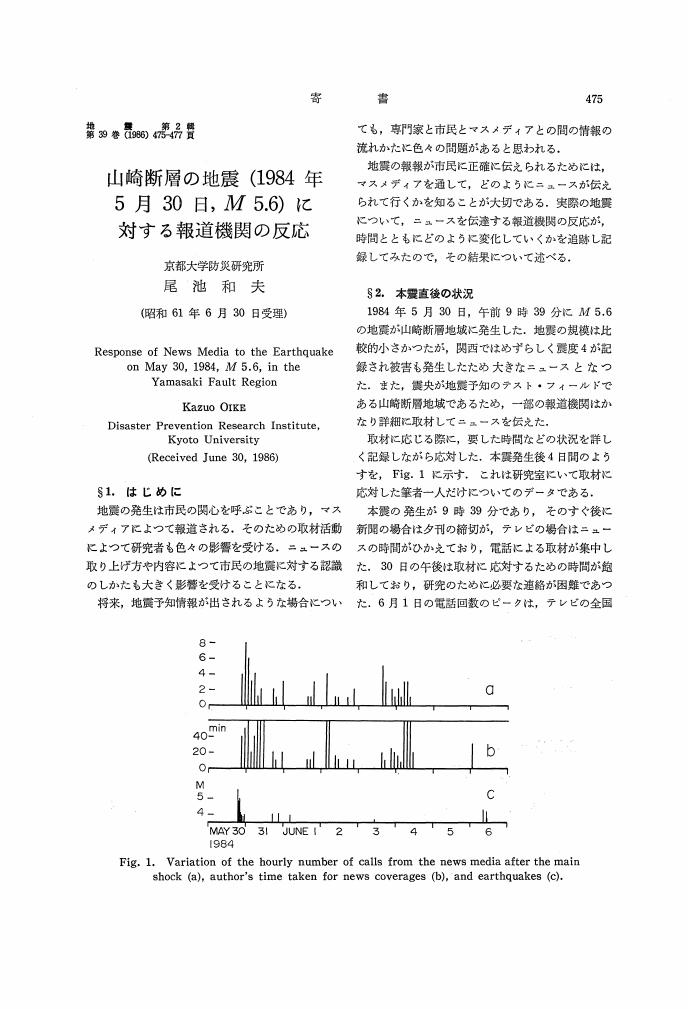3 0 0 0 OA 地震の確率予報
- 著者
- 佃 為成
- 出版者
- 公益社団法人 日本地震学会
- 雑誌
- 地震 第2輯 (ISSN:00371114)
- 巻号頁・発行日
- vol.56, no.1, pp.11-20, 2003-06-02 (Released:2010-03-11)
- 参考文献数
- 7
- 被引用文献数
- 2 1
A new probability process model for earthquake forecast is presented based on Bayesian treatment. The prior probability at the beginning of this process is estimated from long-term data from earthquake history and active fault activities in a target area. The posterior probability is deduced from Bayes' theorem in terms of the prior probability and two conditional probabilities: “alarm rate” and “null alarm rate”. The former is defined to be the probability that a precursory anomaly is detected on condition that an earthquake is accompanied, and the latter to be that on condition that no earthquake is accompanied. These probabilities are estimated mainly by statistical tests of previously accumulated observation data. The test consists of trials of detecting anomaly during each assigned detecting period and of registering earthquake events during the corresponding hypothetical forecasting period. Regarding the estimated posterior probability as the prior probability for the next step of the Bayesian process, we will obtain a new posterior probability when data from another anomaly event is input into the process. Successive application of this procedure continues to renew the posterior probability until a dicision is made to issue an earthquake warning. The final posterior probability pN for N independent anomaly observations with alarm rate qi and null alarm rate si for i=1, 2, …N is given byPN=x1x2…xN/x1x2…xN+a1-p0x1x2…xN, where p0 is the first prior probability, a1=(1-p0)/p0, xi=qi/si and the approximation (-) is valid if pN<<1. The well known terms, “secular probability” and “success rate” are interpreted in the above framework to be a prior probability and the induced posterior probability, respectively. The ratio of alarm rate to null alarm rate, i. e., xi in the above formula, for each precursory anomaly observation is a key factor for reliability on earthquake prediction. The probability gain, i. e., the ratio of the posterior probability to the prior probability, is approximated to be the product of the above ratios.
3 0 0 0 OA 1792年島原眉山崩壊に伴つた津波の数値実験
- 著者
- 相田 勇
- 出版者
- 公益社団法人 日本地震学会
- 雑誌
- 地震 第2輯 (ISSN:00371114)
- 巻号頁・発行日
- vol.28, no.4, pp.449-460, 1975-12-10 (Released:2010-03-11)
- 参考文献数
- 13
- 被引用文献数
- 1 3
On May 21, 1792, a gigantic collapse of Mt. Mayuyama in Shimabara Peninsula, Kyushu, occurred. Following this event, a severe tsunami of about 10 meters in height was generated by the landslide and attacked the coast of Ariake-kai, killing more than 14, 500 persons. Many historical documents tell us the phenomena of this tsunami in fair details, so that we attempted to reconstruct a numerical model of the tsunami consistent with the historical data. In the numerical computation, a finite difference method with a leap-frog system is adapted, and two kinds of source input are tried; one is the prescrived water mass transport normal to shore line and the other the vertical displacement of sea bottom. When the transport of 18, 000m3/min (current speed-20m/sec) per unit length of shore on the center line of landslide area is assumed to be continued during 2 to 4 min, the computed waves agree fairly well with the real tsunami behaviors, the height of tsunami in various places along the coast and the order of the maximum crest in the sequence of a wave train. Therefore, it seems probable that the extraordinary flow of water normal to the shore occurred by some physical mechanisms of the mountain collapse.The energy of this tsunami is estimated to be about 5×1019erg, and this is about 1/100-1/1000 of the available potential energy of the slided material due to the collapse of the mountain. It is significant that the tsunami energy is several times larger than that of the 1968 Hyuganada Earthquake (M=7.5). The wave spreaded over a wide area and gave distructive damages to the coast more than 120km on both side of Ariake-kai.
3 0 0 0 弘化四年(1847年)越後高田の地震における年月日の取り違え
- 著者
- 加納 靖之
- 出版者
- 公益社団法人 日本地震学会
- 雑誌
- 地震 第2輯 (ISSN:00371114)
- 巻号頁・発行日
- vol.69, pp.41-47, 2016 (Released:2017-01-07)
- 参考文献数
- 24
- 被引用文献数
- 1
3 0 0 0 OA GPS連続観測による日本列島上下地殻変動とその意義
- 著者
- 村上 亮 小沢 慎三郎
- 出版者
- 公益社団法人 日本地震学会
- 雑誌
- 地震 第2輯 (ISSN:00371114)
- 巻号頁・発行日
- vol.57, no.2, pp.209-231, 2004-12-27 (Released:2010-03-11)
- 参考文献数
- 43
- 被引用文献数
- 1 6
To evaluate a reliability of GPS vertical data we mapped vertical crustal deformation field of Japan using continuous GPS measurements with a nationwide dense network (GEONET) of the Geographical Survey Institute during the period from 1996 to 2003. We confirmed that the GPS vertical deformation field reasonably agrees with those derived from leveling, tidal record and geomorphologic analysis. The conformity with the other data sets suggests a dependability of the GPS vertical results. The GPS data illustrate details of a spatial pattern of the vertical deformation field and manifest their usefulness when applied to constrain tectonic models. A subsidence along the pacific coast of the southeastern Hokkaido propounds a possibility of a downdip extension of a plate coupling reaching to the depth of about 80km. Uplift around Hidaka mountains in the central Hokkaido suggests a present-day mountain building process at least during the interseismic period. An apparent subsidence found in the central mountainous region of the central Honshu island contrasts sharply with the presumed uplift through Quaternary inferred from geomorphologic analyses. Vertical deformations along the Nankai trough in the southwestern Japan can be attributed to an elastic deformation due to a dragging of the subducting Philippine Sea plate. The GPS result confirms a coupling of plates and a resultant strain accumulation in the Tokai region. Those results demonstrate the usefulness of the GPS vertical data and encourage us in further applications in the studies to understand ongoing tectonic processes in Japan.
3 0 0 0 OA 九十九里浜における元禄16年 (1703年) 津波の供養碑
- 著者
- 羽鳥 徳太郎
- 出版者
- 公益社団法人 日本地震学会
- 雑誌
- 地震 第2輯 (ISSN:00371114)
- 巻号頁・発行日
- vol.28, no.1, pp.98-101, 1975-04-10 (Released:2010-03-11)
- 参考文献数
- 3
- 被引用文献数
- 3
3 0 0 0 OA 「稻むらの火」の教方に就て
- 著者
- 今村 明恒
- 出版者
- 公益社団法人 日本地震学会
- 雑誌
- 地震 第1輯 (ISSN:00371114)
- 巻号頁・発行日
- vol.12, no.8, pp.360-374, 1940-08-25 (Released:2010-11-17)
3 0 0 0 OA 第3部 研究の思い出 深発地震を中心として
- 著者
- 和達 清夫
- 出版者
- 公益社団法人 日本地震学会
- 雑誌
- 地震 第2輯 (ISSN:00371114)
- 巻号頁・発行日
- vol.34, no.special, pp.180-184, 1981-09-25 (Released:2010-11-17)
- 被引用文献数
- 1
3 0 0 0 OA 伊豆諸島周辺における津波の規模
- 著者
- 羽鳥 徳太郎
- 出版者
- 公益社団法人 日本地震学会
- 雑誌
- 地震 第2輯 (ISSN:00371114)
- 巻号頁・発行日
- vol.44, no.4, pp.297-303, 1991-12-24 (Released:2010-03-11)
- 参考文献数
- 13
Based on an epicentral distance dependence of tsunami amplitude observed at tide stations, the tsunami magnitudes were obtained to be m=-2 and m=-1 for the Oshima-Kinkai tsunami of Feb. 20, 1990 and the Tokaido-Oki tsunami of Sept. 24, 1990, respectively. The locality on magnitudes of the tsunamis generated along the Izu-Mariana Island-Arc since 1900 are discussed in relation to earthauake magnitude. According to the statistical relation, the magnitude values (Imamura-Iida scale) of the tsunamis generated near the trench triple junction off Boso Peninsula are one to two grades larger than the average tsunami magnitude. Such tsunamis were mostly caused by low-frequency earthquake with the high-angle dip-slip fault. While, the magnitudes of the tsunamis generated off the west side of Oshima Is. are one grade less than the average value, with caused by earthquakes of the strike-slip type. The magnitudes of a few tsunamis generated on the ridge were larger than the average value. Especially, the 1984 Torishima-Kinkai tsunami had an abnormal magnitude. The regional difference of seismic mechanisms were found by the deviation of tsunami magnitudes.
3 0 0 0 OA 慶長16年 (1611年) 会津地震による地変と地震断層
- 著者
- 寒川 旭
- 出版者
- 公益社団法人 日本地震学会
- 雑誌
- 地震 第2輯 (ISSN:00371114)
- 巻号頁・発行日
- vol.40, no.2, pp.235-245, 1987-06-25 (Released:2010-03-11)
- 参考文献数
- 18
- 被引用文献数
- 2 3
In the morning of September 27, 1611, a strong earthquake hit the Aizu Basin and its surroundings. The damage and its location are thoroughly described in old documents. Landslides occurred in many places on the upthrown side of the Aizu active fault system, which borders the western fringe of the basin. The earthquake fault occurred along the active fault system and dammed up the Nippashi (Ohkawa) River, forming a small lake. The altitude of the lake is inferred to have been 174.5-175m above sea level and depth about 2-3m. The lake is assumed to have been 2-2.5km wide and 4km long, which coincides with the description of old documents. Some villages were submerged and moved outside of the lake. Some part of the ancient Echigo Highway was also submerged and were rebuilt about 4km southward. The earthquake is believed to be caused by the Aizu active fault system. The magnitude of the earthquake is calculated at about M7.3, based on the vertical displacement (2.5m) of the earthquake fault.
3 0 0 0 OA 地震発生についての相転移論
- 著者
- 笠原 順三 大野 一郎 飯田 汲事
- 出版者
- 公益社団法人 日本地震学会
- 雑誌
- 地震 第2輯 (ISSN:00371114)
- 巻号頁・発行日
- vol.22, no.3, pp.201-209, 1969-11-30 (Released:2010-03-11)
- 参考文献数
- 7
When a crystal structure of ammonium fluoride, NH4F, reversibly transforms from Wurtzite structure to NaCl structure at ca. 4kb, a number of small elastic shocks are accompanied with the volume change by the rapid phase transition for polycrystalline specimen. These shocks are also generated during the lowering pressure run, where NaCl structure transforms to Wurtzite structure. If we assume that each of the shocks corresponds to a phase transition in a small volume in the specimen, the amount of the reactant is given by the accumulated number of shocks. Fitting the bulk rate of the phase transition by the equation of the rate theory; dX/dt=K(1-X)p, where X is the mole fraction of the reactant at the time t, we obtain p≈1 and K≈10-1sec-1. The present result shows that the phase transition is the first order reaction and the bulk rate of the phase transition is in the order of 10-1sec-1, although the process of the phase transition is not continuous but is the superposition of very rapid ones with elastic wave radiation.
3 0 0 0 OA 日本列島と周辺海域の地震地体構造区分
- 著者
- 垣見 俊弘 松田 時彦 相田 勇 衣笠 善博
- 出版者
- 公益社団法人 日本地震学会
- 雑誌
- 地震 第2輯 (ISSN:00371114)
- 巻号頁・発行日
- vol.55, no.4, pp.389-406, 2003-03-15 (Released:2010-03-09)
- 参考文献数
- 49
- 被引用文献数
- 9
A new seismotectonic province map of the Japanese Islands and the adjacent areas, which carries maximum magnitudes of earthquake (Mmax) expected for the individual provinces, has been prepared as a revised edition of Kakimi et al. (1994). The major part of the mapped region constitutes an island arc-trench system, which is surrounded by Northwest Pacific Basin (1), Shikoku Basin (2), Philippine Basin (3), Kurile Basin (4), Japan Sea Basins (5), and Korean Peninsula and Tonhai Continental Shelf (6). All of the peripheral provinces have too low seismicity to be given Mmax. The island arc-trench system is subdivided into the following constituent arcs: Kurile Arc (7), Northeast Honshu Arc (8), Izu-Bonin Arc (9), Southwest Honshu Arc (10), Ryukyu Arc (11), Sakhalin Arc (12), and the Tectonic Belt along the Eastern Margin of Japan Sea (13). While the constituent arcs 7 to 11 are divided into three tectonic belts, which remarkably differ from each other in tectonic, seismic, and volcanic activities, from the trench to the inland: Continental Slope on the Trench Side (A), Non-volcanic Outer Belt (B), and Volcanic Inner Belt (C), the constituent arc 10 alone has additionally the Continental Slope on the Marginal Sea Side (D). Province 12 started developing in Late Mesozoic and functioned as a collision belt between the North American Plate (NA) and the Eurasian Plate (EUR) in Late Cenozoic, whereas province 13 is considered to form a current collision belt between NA and EUR plates. Province 11X, Okinawa Trough, is defined as a current rift zone developing between the Tonhai Continental Shelf and the Ryukyu Arc. Some of the provinces are further divided into subprovinces in response to local differences in active faults, seismicity, Mmax etc.All the active faults on land are grouped into seismogenic faults (Matsuda, 1990), which are considered to generate characteristic earthquakes. The magnitudes of earthquake expected for the seismogenic faults (MLmax) are estimated by the equation: log L=0.6ML-2.9 (Matsuda, 1975), where L is the length of the faults in kilometers. The maximum magnitude of earthquake expected for seismogenic faults (MLmax) and the maximum one for historical shallow earthquakes (Mhmax) are compared in each province to choose the larger one as the expected maximum earthquake magnitude (Mmax) for the province. Since no method to decide a seismogenic unit from offshore active faults has been established, Mhmax is tentatively adopted as the Mmax representing the province. Extraordinarily long faults found in inland provinces, which are called the designated faults (Matsuda, 1990), are excluded from estimation of the Mmax. None of the magnitudes of earthquake expected for the designated faults is shown here, because they should be individually estimated. All of the information, such as tectonic geomorphology and geology, characteristics of active (seismogenic) faults, historical earthquakes, modern seismicity, and other, is put into a table to facilitate the identification of a seismotectonic province and the determination of the Mmax and the designated faults. The details of the boundaries between seismotectonic provinces are shown in another table.
3 0 0 0 OA 1703年元祿関東地震の震源域と相模湾における大地震の再来周期 (第1報)
- 著者
- 石橋 克彦
- 出版者
- 公益社団法人 日本地震学会
- 雑誌
- 地震 第2輯 (ISSN:00371114)
- 巻号頁・発行日
- vol.30, no.3, pp.369-374, 1977-12-05 (Released:2010-03-11)
- 参考文献数
- 26
- 被引用文献数
- 3
3 0 0 0 OA 房総半島南西部岩井低地の離水海岸地形からみた大正型関東地震の発生年代と再来間隔
- 著者
- 宍倉 正展 原口 強 宮内 崇裕
- 出版者
- 公益社団法人 日本地震学会
- 雑誌
- 地震 第2輯 (ISSN:00371114)
- 巻号頁・発行日
- vol.53, no.4, pp.357-372, 2001-06-15 (Released:2010-03-11)
- 参考文献数
- 32
- 被引用文献数
- 1 8
Two major historical earthquakes of the 1703 Genroku Kanto Earthquake (M 8.2) and the 1923 Taisho Kanto Earthquake (M 7.9) occurred along the Sagami Trough, where the Philippine Sea Plate subducts beneath the North American Plate. As a result of the coseismic crustai movements associated with these earthquakes and with the repeated characteristic earthquakes of two types (the Genroku-type Earthquake and the Taisho-type Earthquake), Holocene emerged shoreline topography has developed along the southern coast of the Boso Peninsula. We investigated the emerged shoreline topography and beach sediments in the Iwai Lowland with help of a new sampling method using the long geo-slicer to clarify the timing and recurrence interval of the Taisho-type Earthquake. A series of ten narrow emerged beach ridges, which are named the BR-I to BR-X in descending order, are distributed below the highest emerged shore platform, 15.5m high above sea level in the lowland. At least eleven times of coseismic events, probably the Taisho-type Earthquake, can be recognized from the number of the emerged shoreline topography. Based on the 14C ages and sedimentary sequences related to the BR-I-IX, the Taisho-type Earthquake occurred at least three times between 6825-6719 cal yrs BP and 5304-5055 cal yrs BP. After the other three non-dated events succeeded, four events are confirmed at 3300-3100 cal yrs BP, before 2306-2118 cal yrs BP, 1292-1264 cal yrs BP and around 900 cal yrs BP. The lowest BR-X was judged to be emerged during the 1923 event by comparing between the topographic map issued in 1886 and the present one. Analyzing intermittent emergent age of beach ridges, the recurrence interval of the Taisho-type Earthquake is within 990 years, and is 380 years at shortest.
3 0 0 0 OA 土佐に於ける寶永安政兩度津浪の高さ
- 著者
- 今村 明恒
- 出版者
- 公益社団法人 日本地震学会
- 雑誌
- 地震 第1輯 (ISSN:00371114)
- 巻号頁・発行日
- vol.10, no.9, pp.394-404, 1938-09-25 (Released:2010-03-09)
3 0 0 0 OA 日本海溝周辺における太平洋プレート内の地震発生機構
- 著者
- 古賀 祥子 伊藤 喜宏 日野 亮太 篠原 雅尚 海野 徳仁
- 出版者
- 公益社団法人 日本地震学会
- 雑誌
- 地震 第2輯 (ISSN:00371114)
- 巻号頁・発行日
- vol.64, no.2, pp.75-90, 2012-01-25 (Released:2012-02-20)
- 参考文献数
- 32
- 被引用文献数
- 2 4
A double-planed shallow seismic zone has been found in the northeastern Japan forearc region. However, the characterizations of the focal mechanisms of earthquakes in this zone, especially the lower plane events, cannot be carried out adequately due to low seismicity and poor station coverage on the focal sphere of the onshore P-wave polarity data. In this study, we determine the focal depth using the sP depth phase and the focal mechanisms using the P-wave initial motions observed by the ocean bottom cabled seismic stations and temporary autonomous ocean bottom seismic networks off Miyagi, as well as the onshore seismic networks. Seven focal mechanism solutions of events were precisely determined. Using the classification based on the dip angles of the T, B and P axes, we classified 21 weakly constrained focal mechanisms of other events having poor station coverage. All the determined solutions were of the thrust-faulting type regardless of the focal depth. The offshore observations helped considerably in constraining the focal mechanisms of these far-offshore earthquakes, especially their rake angles. Although previous studies had reported that the focal mechanisms of the upper and lower plane events show predominantly normal and reverse faulting respectively, our result showed that the thrust events in the upper plane seem to occur on the plate boundary. We found that the focal mechanisms change from normal faulting in the upper plane to reverse faulting in the lower plane at a depth of 15km from the plate boundary, possibly defining the depth of the neutral plane in the northeastern Japan forearc region included in the source area of the 1933 Mw8.4 Sanriku earthquake. The western edge of the normal faulting events along the upper plane is located about 70km inward from the trench axis. These results suggest that the earthquake-generating stress field in the double-planed shallow and deep seismic zone in the northeastern Japan arc can be explained by the bending-unbending model of the subducting Pacific plate.
3 0 0 0 OA 文禄五年閏七月九日 (1596年9月1日) の地震による伊予での被害を示す史料
- 著者
- 中西 一郎
- 出版者
- 公益社団法人 日本地震学会
- 雑誌
- 地震 第2輯 (ISSN:00371114)
- 巻号頁・発行日
- vol.55, no.3, pp.311-316, 2002-12-15 (Released:2010-03-09)
- 参考文献数
- 19
- 被引用文献数
- 1 2
3 0 0 0 OA 実在しない天福元年二月五日 (ユリウス暦1233年3月17日) の南海巨大地震
- 著者
- 石橋 克彦
- 出版者
- 公益社団法人 日本地震学会
- 雑誌
- 地震 第2輯 (ISSN:00371114)
- 巻号頁・発行日
- vol.51, no.3, pp.335-338, 1998-12-25 (Released:2010-03-11)
- 参考文献数
- 19
- 被引用文献数
- 2
3 0 0 0 OA 非地震性すべりの時空間変化と大地震の発生予測
- 著者
- 飯尾 能久 松澤 暢 吉田 真吾 加藤 照之 平田 直
- 出版者
- 公益社団法人 日本地震学会
- 雑誌
- 地震 第2輯 (ISSN:00371114)
- 巻号頁・発行日
- vol.56, no.2, pp.213-229, 2003-09-16 (Released:2010-03-11)
- 参考文献数
- 97
- 被引用文献数
- 1
We review recent studies on spatial distribution of asperities, and space-time variations of aseismic slips deduced from analyses of strong ground motions, displacement rates, continuous crustal deformations, and repeated microearthquakes in the Sanriku-oki region along the Japan trench. These various analyses suggest a possible scenario about occurrence of large earthquakes; asperities, which are defined as areas of large slips at earthquakes, repeatedly break when the stresses at asperities are loaded and reach to their strengths by aseismic slips occurring in the surrounding regions. If this scenario is the case and we estimate the strength, extent of asperities, and space-time variations of aseismic slips around the asperities, we will be able to forecast occurrence of large earthquakes to some extent. Moreover, we will be able to simulate the whole subduction process including seismic cycles along a subducting plate boundary if we find a conclusive constitutive law of frictional slip and succeed in estimating detailed distribution of the frictional parameters on the plate boundary. Although loading and generation mechanisms of intraplate earthquakes might not be the same as the interplate ones, the slow slips along the fault surface must play an important role for their generation.
3 0 0 0 OA 東北日本太平洋側における津波の波源
- 著者
- 羽鳥 徳太郎
- 出版者
- 公益社団法人 日本地震学会
- 雑誌
- 地震 第2輯 (ISSN:00371114)
- 巻号頁・発行日
- vol.27, no.4, pp.321-337, 1974-12-30 (Released:2010-03-11)
- 参考文献数
- 51
- 被引用文献数
- 6
Source areas of the tsunamis generated in northeast Japan since 1896 are compiled on a bathymetric chart (Newly estimated: 14; Reanalyses: 14). Sources of large tsunamis lie on the steep continental slope off the Sanriku coast. Most of small tsunami sources are located in the sea shallower than the depth of 2000m. Source dimensions are closely related with earthquake magnitude; the Utsu formula for the relation between the earthquake magnitude and aftershock area can be applied well for the tsunami source area. Generally speaking, the magnitudes of tsunami correspond to earthquake magnitude. However, a few tsunamis generated in the vicinities of the west Aomori and Miyagi regions are especially small in comparison with those at other regions.Judging from the initial motion on tsunami records, most of tsunamis off the Sanriku coast seem to be generated by the reverse fault type earthquake. The sense, up or down, of the initial motion of the 1896 Sanriku tsunami is opposite to that of the 1933 tsunami which is caused by a normal fault earthquake. This suggests that the 1896 tsunami was generated by the reverse fault earthquake. Source dimension of the 1933 tsunami is newly revised and found to be about 300km. This area is smaller than the former estimations, because arrival times at the tide stations of Hokkaido were read too early by misunderstanding a noise as the first motion.
2 0 0 0 OA 山崎断層の地震 (1984年5月30日, M5.6) に対する報道機関の反応
- 著者
- 尾池 和夫
- 出版者
- 公益社団法人 日本地震学会
- 雑誌
- 地震 第2輯 (ISSN:00371114)
- 巻号頁・発行日
- vol.39, no.3, pp.475-477, 1986-09-25 (Released:2010-03-11)








